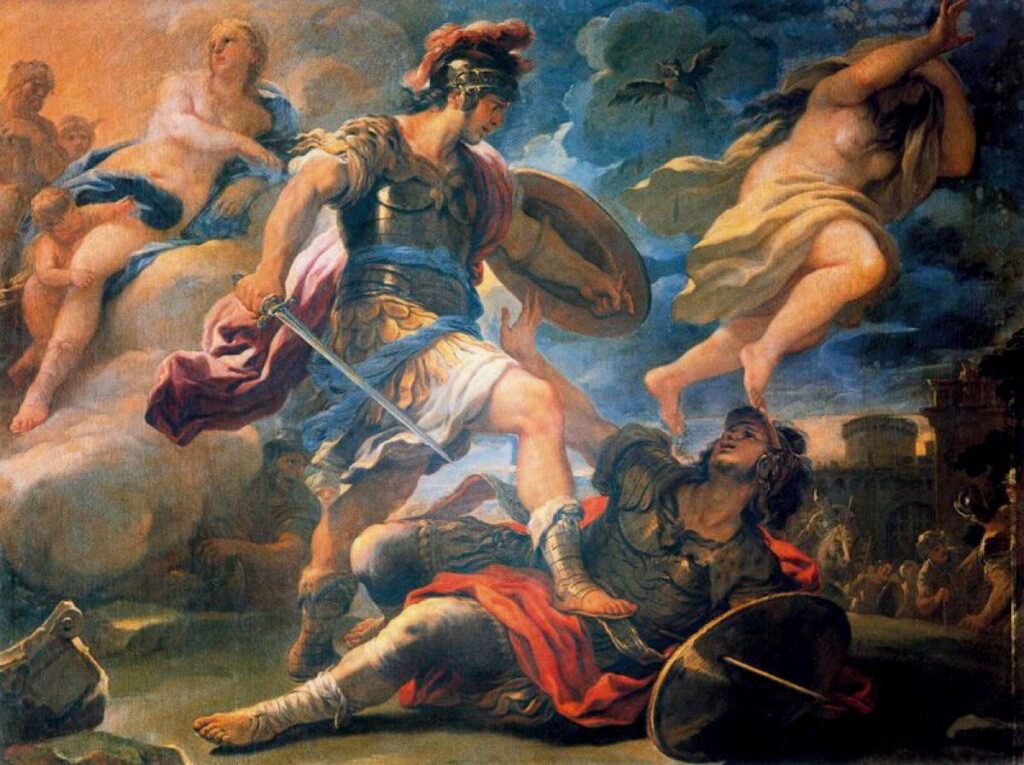Changing Paintings: 68 Apotheosis of Aeneas

Macareus, one of the survivors from the Odyssey, has been giving his account of the sojourn of Ulysses and his men on Circe’s island. Having told of their arrival and transformation into pigs, he concludes with a cautionary tale of what happens to those who don’t submit to Circe’s desires. One of Circe’s assistants showed Macareus a marble statue of a youth with a woodpecker on his head. When Macareus asked why that was in the shrine, the assistant explained that it all came about as a result of Circe’s magic powers.
Picus had been the king of Latium, and drew admiring glances from nymphs wherever he went. He fell in love with a beautiful young woman who sang so wonderfully that she was named Canens (Latin for singing), and they lived together in marital bliss. One day when Picus was out hunting on his horse, Circe caught sight of him from the undergrowth. Her desire for him was immediate and intense, so she worked her magic to lure the king into a thicket, in pursuit of a phantom boar she had conjured up.
Circe confronted him and told him of her desire, but he refused her in faithfulness to Canens. Despite Circe repeatedly pleading with him, Picus stood firm and refused her time and again. The sorceress became angry, warning him that he would pay for his obstinacy and would never return to his bride. She cast a spell and touched him with her wand, transforming him into a woodpecker.
When his courtiers searching for the king, they stumbled into the sorceress, and accused her of being responsible for his disappearance. She promptly transformed each of them into a wild animal as well. Picus’ wife Canens was beside herself with worry, and roamed the countryside looking for her husband. She pined away in her grief and vanished into thin air at a place now named after her. With that Macareus concludes his story.
Luca Giordano (1634–1705), Picus and Circe (date not known), oil on canvas, 99.8 x 124 cm, location not known. Wikimedia Commons.
The only dedicated account available of this myth is Luca Giordano’s Picus and Circe, probably painted around 1670. This shows Circe trying to seduce Picus, and the king resisting her advances. By their expressions, she has just told him that he will pay for his refusal, and is working her magic to transform him into a woodpecker. Already he has grown feathery wings, and at the upper right there is the silhouette of a woodpecker as an ominous reminder of the fate that awaits him at any moment.
There are more paintings showing Circe in the company of various enchanted birds and animals, including the former King Picus. Two of the more remarkable examples are both by Dosso Dossi, one painted in about 1515, the second probably fifteen years later.
Dosso Dossi (–1542), Circe and her Lovers in a Landscape (c 1514-16), oil on canvas, 100 × 136 cm, National Gallery of Art, Washington, DC. Wikimedia Commons.
Dossi’s Circe and her Lovers in a Landscape (c 1514-16) is a remarkably early and realistic mythological landscape, with deep rustic lanes, trees, and a distant farmhouse. Circe leans naked at the foot of a tree going through spells on a large tablet, with a book of magic open at her feet. Around her are some of the men who she took a fancy to and transformed into wild creatures. There’s a spoonbill, a small deer, a couple of dogs, a stag, and up in the trees an owl and what could well be a woodpecker, in the upper right corner.
Dosso Dossi (–1542), Melissa (Circe) (c 1518-1531), oil on canvas, 176 × 174 cm, Galleria Borghese, Rome. Wikimedia Commons.
Dossi’s later painting of Melissa (Circe) (c 1518-1531) is also set in a richly detailed landscape. Circe sits inside a magic circle, around which are inscribed cabalistic words. In the upper left corner are small homunculi apparently growing on a tree. On the left is a large dog, and perched on top of a suit of armour is a bird, most probably a woodpecker.
Once Aeneas has buried his nurse in a marble sepulchre, he and his crew set sail on the final leg of their journey from Troy to Latium in Italy.
Once they arrive, Aeneas and his former Trojans have to fight Turnus, king of the Rutuli, for Latinus’ throne and the hand of Lavinia in marriage. This proves a long and bitter struggle, in which Aeneas is aided by others, but among those who refuses to assist him is Diomede in Apulia. In defending his refusal to aid Aeneas, Diomede tells the story of his return from the Trojan War, which proved a desperate journey. His colleague Acmon had rashly speculated what more Venus could have done to harm them, and taunted her, for which she transformed them all into white seabirds. Venulus, Aeneas’ envoy to Diomede, also saw a grotto where a shepherd had offended Pan and been turned into an oleaster tree.
Antonio Tempesta (1555-1630), Acmon and his Friends Changed into Birds by Venus (date not known), etching in illustrated edition of Ovid’s Metamorphoses, Book XIV, 10.3 x 11.7 cm, location not known. Wikimedia Commons.
Antonio Tempesta’s etching of Acmon and his Friends Changed into Birds by Venus from about 1600 is the only pictorial representation that I have been able to find of that story told by Diomede, and for its period it tells it well.
During the war with Turnus, enemy forces are sent to burn Aeneas’ fleet of ships. As they were built with pinewood frames, they burned well. But Juno intervenes, brings a hailstorm, drags the burning ships underwater, and transforms them into sea-nymphs. The city of Ardea falls to Aeneas when he kills Turnus, and from its ashes and ruins comes the heron.
Artist not known, Trojan Ships turned into Nymphs (c 400), Vergilius Vaticanus, Aeneid Book IX, illumination on parchment, 21.9 × 19.6 cm, Biblioteca Apostolica Vaticana, The Vatican. Wikimedia Commons.
The single illustration that I have been able to find of the transformation of the burning Trojan ships into nymphs comes from one of the most precious documents featured in this series: the Vergilius Vaticanus manuscript of Virgil’s works dating back to about 400 CE. Three ships are seen already transformed into the head, arm, and body of nymphs at the far right, although there is no sign of any fire or hailstorm. The left and centre show Aeneas fighting Turnus.
The Vergilius Vaticanus is very special, as one of the oldest surviving sources for the text of the Aeneid, and one of only three ancient illustrated manuscripts containing classical literary works. At one time it belonged to Pietro Bembo, an Italian scholar who is commemorated in the font name.
Luca Giordano (1634–1705), Aeneas and Turnus (date not known), oil on canvas, 176 × 236 cm, Palazzo Corsini al Parione, Florence, Italy. Wikimedia Commons.
Luca Giordano’s Aeneas and Turnus from the late 1600s is one of the few paintings showing the battle between Aeneas and Turnus. The Trojan hero here has Turnus on the ground, under his right foot. At the lower left is one of Aeneas’ ships, which hasn’t been transformed into a nymph. Venus, Aeneas’ mother, and Cupid, his half-brother, are at the upper left, and the goddess at the upper right is either Minerva (with her owl), or Juno; as losers in the Judgement of Paris, both bore a grudge against the Trojans.
With the end of Aeneas’ life drawing near, his mother Venus campaigns among the deities for him to be transformed into a god when he dies. They agree, as do Jupiter and Juno, allowing Venus to descend in her chariot drawn by doves. Aeneas is then washed thoroughly by the river Numicius before the goddess anoints him with nectar and ambrosia to transform him into the new god Indiges.
Peter Candid (c 1548–1628), Aeneas Taken to Olympus by Venus (date not known), media and dimensions not known, Kaiser-Friedrich-Museums-Verein, Berlin, Germany. Wikimedia Commons.
Peter Candid’s Aeneas Taken to Olympus by Venus from around 1600 shows Venus at the right, in her chariot with Cupid, anointing Aeneas, on the left, with nectar and ambrosia. Above them is the pantheon, arrayed in an imposing semicircle, and above them Jupiter himself, clutching his thunderbolts and ready to receive the new god.
Giovanni Battista Tiepolo (1696-1770), The Apotheosis of Aeneas (sketch) (c 1765), oil on canvas, 72.2 x 51.1 cm, Harvard Art Museums/Fogg Museum (Allston Burr Bequest Fund), Cambridge, MA. Courtesy of Harvard Art Museums/Fogg Museum.
Tiepolo’s sketch for a fresco ceiling in the Royal Palace in Madrid, The Apotheosis of Aeneas from about 1765, is another impressive account. The artist made this a little more elaborate by combining the apotheosis with the presentation of arms to Aeneas by his mother Venus. Aeneas is to the left of centre, dressed in prominent and earthly red. Above and to the right of him is his mother, Venus, dressed in white, ready to present the arms which have been forged for him by Vulcan, her partner, who is shown below supervising their fabrication. Aeneas’ destination is the Temple of Immortality, glimpsed above and to the left of him, through a break in the divine clouds.
Ovid then lists successive rulers of Latium and Alba, the city founded by Aeneas, up to the reign of King Proca, the setting for his next story.



